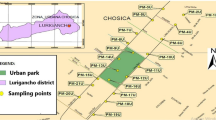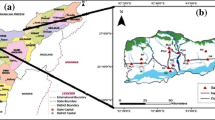Abstract
Purpose
The aim of this work was to investigate the possibility of using several bush and arboreal plant species, usually present as ornamental plants in street and parks, as environmental indicators of pollution. This is a research paper that evaluates the real possibility of using a fast and low-cost procedure to evaluate the pollution degree through data obtained from plant species growing within an urban environment.
Methods
Leaves of six different bush and arboreal species were collected from different parts of Madrid (Spain), ranging from highly polluted considered areas to medium and low contaminated ones. A total of 66 chemical elements, from major to minor and trace, were determined for every leaf sample by inductively coupled plasma-mass spectrometry. Statistical analyses were carried out using mainly box and whisker plots, linear discriminant analysis and cluster analysis.
Results
The pollution by different elements of the studied areas of Madrid cannot be considered generally dangerous for human health. The level detected for the contaminants, in general, is similar or lower than other urban cities. Pb and V concentrations in plant samples tend to increase as traffic density increases. The different studied plant species showed a different capability of accumulation of certain elements. Cedrus deodara accumulates specially Ag, Hg, Mo and V; Cupressus sempervirens, Zr; Pinus pinea, As and Sb; Nerium oleander Ni, Pb, Mo and Se; Ligustrum ovalifolium, Sc and V; and Pittosporum tobira, Ag, Cd, Rb and Sc.
Conclusions
The leaves and needles collected from bush and arboreal plants common in this city have demonstrated to be useful to evaluate the level of pollution not only through the chemical analysis but also through the recognition of the visual injury symptoms. The application of multivariate statistical techniques combined with determining of element concentration and correlation analysis has been proved to be an effective tool for reach the objectives of the present work. This allows visualising quickly the damages and leading the sampling through the points of high-level pollution, saving analysis, time and money.







Similar content being viewed by others
References
Aceto M, Abollino O, Conca R, Malandrino M, Mentasti E, Sarzanini C (2003) The use of mosses as environmental metal pollution indicators. Chemosphere 50:333–342
Aksoy A, Öztürk MA (1997) Nerium oleander L. as a biomonitor of lead and other heavy metal pollution in Mediterranean environments. Sci Total Environ 205:145–150
Alaimo MG, Lipani B, Lombardo MG, Orecchio S, Turano M, Melati MR (2000) The mapping of stress in the predominant plants in the city of Palermo by lead dosage. Aerobiologia 16:47–54
Baycu G, Tolunay D, Özden H, Günebakan S (2006) Ecophysiological and seasonal variations in Cd, Pb, Zn and Ni concentrations in the leaves of urban deciduous trees in Istanbul. Environ Pollut 143:545–554
Bargagli R, Monaci F, Agnorelli C (2003) Oak leaves as accumulators of airborne elements in an area with geochemical and geothermal anomalies. Environ Pollut 124:321–329
Bergamaschi L, Rizzio E, Giaveri G, Loppi S, Gallorini M (2007) Comparison between the accumulation capacity of four lichen species transplanted to a urban site. Environ Pollut 148:468–476
Berlizov AN, Blum OB, Filby RH, Malyuk IA, Tryshyn VV (2007) Testing applicability of black poplar (Populus nigra L.) bark to heavy metal air pollution monitoring in urban and industrial regions. Sci Total Environ 372:693–706
Blum O, Bynerowicz A, Manning W, Popovichea L (1997) Ambient trophospheric ozone in Ukranian Carpathian Mountains adn Kiev region: detection with passive samplers and bioindicator plants. Environ Pollut 98:299–304
Brunialti G, Frati L (2007) Biomonitoring of nine elements by the lichen Xanthoria parietina in Adriactic Italy: a restrospective study over a 7-year time span. Sci Total Environ 387:289–300
Carlberg GE, Baumann-Ofstad E, Drangsholt E, Steinnes E (1983) Atmospheric deposition of organic micropollutants in Norway studied by moss and lichen analysis. Chemosphere 12:341–356
Catinon M, Ayrault S, Clocchiatti R, Boudouma O, Asta J, Tissut M, Ravanel P (2009) The anthropogenic atmospheric elements fraction: a new interpretation of elemental deposits tree barks. Atmos Environ 43:1124–1130
Çelik A, Kartal AA, Akdogän A, Kaska Y (2005) Determining the heavy metal pollution in Denizli (Turkey) by using Rubinia pseudoacacia L. Environ Int 31:105–110
Chronopoulos J, Haidouti C, Chronopoulou-Sereli A, Massas I (1997) Variations in plant and soil lead and cadmium content in urban parks in Athens, Greece. Sci Total Environ 196:91–98
Díaz RV, Aldape J, Flores M (2002) Identification of airborne particulate sources, of samples collected in Ticomán, México, using PIXE and multivariate analysis. Nucl Instrum Meth Phys Res B 189:249–253
Duzgoren-Aydin NS (2007) Sources and characteristic of lead pollution in the urban environment of Guangzhou. Sci Total Environ 385:182–195
Fernández-Espinosa AJ, Rossini-Oliva S (2006) The composition and relationships between trace elements levels in inhalable atmospheric particles (PM10) and in leaves of Nerium oleander L. and Lantana camara L. Chemosphere 62:1665–1672
Fidalgo-Hijano C, Petit-Domínguez MD, García-Giménez R, Hungría-Sánchez P, Sancho-García I (2005) Higher plants as bioindicators of sulphur dioxide emissions in urban environments. Environ Monit Assess 111:75–88
Fuentes D, Disante KB, Valdecantos A, Cortina J, Vallejo VR (2007) Response of Pinus halepensis Mill. seedlings to biosolid enriched with Cu, Ni and Zn in three Mediterranean forest soils. Environ Pollut 145:316–323
Gajić G, Mitrović M, Pavlović P, Stevanović B, Djurdjević L, Kostić O (2009) An assessment of the tolerance of Ligustrum ovalifolium Hassk. to traffic-generated Pb using physiological and biochemical markers. Ecotoxicol Environ Saf 72:1090–1101
García-Giménez R, Vigil de la Villa R, Petit-Domínguez MD, Rucandio MI (2006) Application of chemical, physical and chemometric analytical techniques to the study of ancient ceramic oil lamps. Talanta 68:1236–1246
Granati L, Cresente MF, Varone L (2007) Long-term monitoring of metal pollution by urban trees. Atmos Environ 42:8273–8277
Günes A, Alpaslan M, Inal A (2004) Plant nutrition and fertilizer. Ankara University. Agriculture Publication Nº.1539, Ankara. Turkey
Isocrono D, Matteucci E, Ferrarese A, Pensi E, Piervittori R (2007) Lichen colonization in the city of Turin (N Italy) based on current and historical data. Environ Pollut 145:258–265
Jacob J, Grimmer G, Hildebrandt A (1993) The use of passive samplers for monitoring polycyclic aromatic hydrocarbons in ambient air. Sci Total Environ 139(149):307–321
Kabata-Pendias A, Pendias H (1986) Trace elements in soils and plants. CRC, Boca Raton, Florida
Lombardo M, Melati RM, Orecchio S (2001) Assessment of the quality of the air in the city of Palermo through chemical and cell analyses on Pinus needles. Atmos Environ 35:6435–6445
Lonati G, Giugliano M, Cernuschi S (2006) The role of traffic emissions from weekends´ and weekdays´ fine PM data in Milan. Atmos Environ 40:5998–6011
Lorenzini G, Grassi C, Nali C, Petiti A, Loppi S, Tognotti L (2006) Leaves of Pittosporum tobira as indicators of airborne trace element and PM10 distribution in central Italy. Atmos Environ 40:4025–4036
Marini F, Magri AL, Balestrieri F, Fabretti F, Marini D (2004) Supervised 776 pattern recognition applied to the discrimination of the floral origin of six types of Italian honey samples. Anal Chim Acta 515:117–125
Matarese Palmieri R, La Pera L, Di Bella G, Dugo G (2005) Simultaneous determination of Cd(II), Cu(II), Pb(II) and Zn(II) by derivative stripping chronopotentiometry in Pittosporum tobira leaves: a measurement of local atmospheric pollution in Messina (Sicily, Italy). Chemosphere 59:1161–1168
Mignorance MD, Valdés B, Rossini-Oliva S (2007) Strategies of heavy metal uptake by plants growing under industrial emissions. Environ Int 33:514–520
Odukoya OO, Arowolo TA, Bamgbose O (2000) Pb, Zn and Cu levels in tree barks as indicator of atmospheric pollution. Environ Int 26:11–16
Onder S, Dursun S (2006) Air borne heavy metal pollution of Cedrus libani (A. Rich.) in the city centre of Konya (Turkey). Atmos Environ 40:1122–1133
Petit-Domínguez MD, Rucandio MI, Galán-Saulnier A, García-Giménez R (2008) Usefulness of geological, mineralogical, chemical and chemometric analytical techniques in exploitation and profitability studies of iron mines and their associated elements. J Geochem Explor 98:116–128
Pignata ML, Gudiño GL, Wannaz ED, Plá RR, González CM, Carreras HA, Orellana L (2002) Atmospheric quality and distribution of heavy metals in Argentina employing Tillandsia capillaris as a biomonitor. Environ Pollut 120:59–68
Rossini-Oliva S, Fernández-Espinosa AJ (2007) Monitoring of heavy metals in topsoils, atmospheric particles and plant leaves to identify possible contamination sources. Microchem J 86:131–139
Rossini-Oliva S, Rautio P (2004) Could ornamental plants serve as passive biomonitors in urban areas? J Atmos Chem 49:137–148
Rossini-Oliva S, Valdés B (2004) Ligustrum lucidum Ait. F. Leaves as bioindicator of the air-quality in a Mediterranean city. Environ Monit Assess 96:221–232
Sardans J, Peñuelas J (2005) Trace element accumulation in the moss Hypnum cupressiforme Hedw. and the trees Quercus ilex L. and Pinus halepensis Mill. in Catalonia. Chemosphere 60:1293–1307
Schauer JJ, Lough GC, Shafer MM, Christensen WF, Arndt, MF, DeMinter JT, Park JS (2006) Characterization of metals emitted from motor vehicles. Health Effects Institute Research Report Number 133
Sirito de Vives AN, Moreira S, Boscolo-Brienza SM, Medeiro JGS, Filho MT, Araujo-Domingues-Zucchi OL, Filho VFN, Cely-Barroso R (2007) Species arboreal as a bioindicator of the environmental pollution: analysis by SR-TXRF. Nucl Instrum Meth Phys Res A 579:494–498
Thomas W (1984) Statistical models for the accumulation of PAH, chlorinated hydrocarbons and trace metals in epiphytic Hypnum cupressiforme. Water Air Soil Pollut 22:351–371
Wegener JWM, Van Schaik MJM, Aiking H (1992) Active biomonitoring of polycyclic aromatic hydrocarbons by means of mosses. Environ Pollut 76:15–18
WHO (2001) Word Healh Organization. Air Quality Guidelines for Europe. WHO European Series number 91, 2nd edn. Regional Office for Europe, Copenhagen
Wolterbeek B (2002) Biomonitoring of trace element air pollution: principles, possibilities and perspectives. Environ Pollut 120:11–21
Wolterbeek H-Th, Bode P (1995) Strategies in sampling and sample handling in the context of large-scale plant biomonitoring surveys of trace element air pollution. Sci Total Environ 176:33–43
Wong CSC, Li X, Thornton I (2006) Urban environmental geochemistry of trace metals. Environ Pollut 142:1–16
Yongming H, Peixuan D, Juji C, Posmentier ES (2006) Multivariate analysis of heavy metal contamination in urban dusts of Xi´an, Central China. Sci Total Environ 355:176–186
Zhou Q, Zhang J, Fu J, Shi J, Jiang G (2008) Biomonitoring: an appealing tool for assessment of metal pollution in the aquatic ecosystem. Anal Chim Acta 606:135–150
Author information
Authors and Affiliations
Corresponding author
Additional information
Responsible editor: Euripides Stephanou
Rights and permissions
About this article
Cite this article
Rucandio, M.I., Petit-Domínguez, M.D., Fidalgo-Hijano, C. et al. Biomonitoring of chemical elements in an urban environment using arboreal and bush plant species. Environ Sci Pollut Res 18, 51–63 (2011). https://doi.org/10.1007/s11356-010-0350-y
Received:
Accepted:
Published:
Issue Date:
DOI: https://doi.org/10.1007/s11356-010-0350-y




